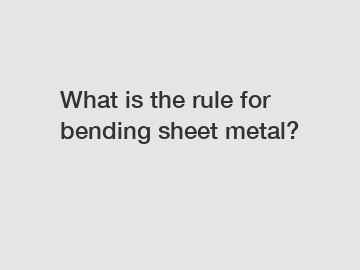What is the rule for bending sheet metal?
What is the rule for bending sheet metal?
Sheet metal is widely used in various industries for its versatility and durability. It can be shaped into different forms and sizes to meet specific requirements of a project. One of the most common processes in working with sheet metal is bending. Bending is the act of deforming the metal by applying force, typically using a press brake machine or by hand. However, there are specific rules to follow when bending sheet metal to ensure accuracy and precision. In this article, we will explore the rule for bending sheet metal and its importance in achieving desired results.
Understanding the Basics of Bending Sheet Metal.

Before diving into the rules, it is essential to have a basic understanding of the bending process. Bending sheet metal involves applying force to a specific area, causing the metal to bend at a particular angle. This requires careful consideration of factors such as material thickness, desired angle, and tooling used for bending.
Rule 1: Minimum Bend Radius.
The first rule to follow when bending sheet metal is the minimum bend radius. Every material has a minimum bend radius requirement, which is the smallest radius a sheet metal can be bent without causing cracks or defects. Going below the minimum bend radius can lead to material failure and compromise the structural integrity of the metal.
Rule 2: Bend Allowance Calculation.
Another critical rule is calculating the bend allowance. Bend allowance refers to the amount of material that is consumed in the bending process. It is necessary to determine the bend allowance accurately to ensure the correct length of the sheet metal before bending. Precise bend allowance calculation can prevent material waste and errors in the final product.
Rule 3: Material Thickness and Bending Force.
The thickness of the sheet metal determines the amount of force required for successful bending. Thicker materials need higher bending forces, while thinner materials require less force. Understanding the relationship between material thickness and bending force is crucial to prevent damage to the metal or the bending tooling.
Rule 4: Springback Compensation.
One rule that often gets overlooked is springback compensation. When bending a sheet metal, it tends to retract slightly after the bending force is released. This phenomenon is known as springback. To compensate for springback, the bending angle must be adjusted slightly beyond the desired angle. Failing to consider springback can result in a final product that does not meet the required specifications.
Conclusion.
Bending sheet metal is a complex process that requires careful attention to various factors. Adhering to the rules mentioned above is crucial in achieving accurate and precise bends without compromising the material's integrity. By following the minimum bend radius, calculating the bend allowance, considering material thickness and bending force, and compensating for springback, one can ensure high-quality results in sheet metal bending projects.
If you are looking for professional assistance in sheet metal bending or have any inquiries regarding sheet metal fabrication, feel free to contact us. Our team of experts is equipped with the knowledge and experience to provide the solutions you need for your specific requirements. Don't hesitate, reach out to us today!
Contact us for all your sheet metal bending needs and inquiries. We have a team of experts ready to assist you in achieving high-quality results.
If you want to learn more, please visit our website panel bending, panel bending machine, panel bending.
73
0
0

Comments
All Comments (0)